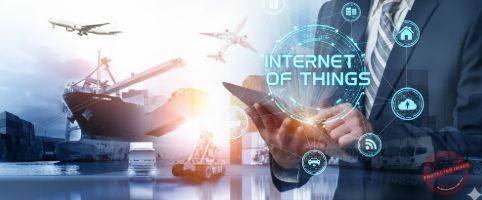How Smart Machines, Connected Operations, and Predictive Intelligence Are Driving the Next Industrial Revolution.
The Rise of Industrial IoT
In the modern industrial landscape, connectivity is becoming the ultimate competitive advantage. The Industrial Internet of Things (IIoT)—a network of smart machines, sensors, and control systems—is transforming how factories, energy grids, and logistics networks operate.
From predictive maintenance and process automation to real-time asset tracking, IIoT is ushering in the era of Industry 4.0, where data-driven intelligence fuels efficiency, sustainability, and growth.
By linking physical operations to digital analytics, IIoT is not merely optimizing production—it’s redefining the very architecture of global industry.
The Smart Factory Revolution
Manufacturing lies at the heart of the IIoT revolution. Connected machinery and AI-driven analytics are creating smart factories capable of monitoring themselves, adjusting in real time, and predicting equipment failures before they happen.
Key innovations include:
-
Predictive maintenance: IoT sensors detect anomalies in vibration, temperature, or pressure, preventing unplanned downtime.
-
Digital twins: Virtual replicas of machines simulate performance and enable data-driven decision-making.
-
Automated quality control: Computer vision and AI ensure defect-free production at scale.
-
Collaborative robots (cobots): Intelligent robots work safely alongside humans to enhance efficiency.
These capabilities are allowing manufacturers to boost uptime, reduce waste, and maintain precision—creating an industrial environment that’s as intelligent as it is productive.
Energy and Utilities: Smarter, Cleaner, and More Reliable
In the energy sector, IIoT is driving the transition to a smart grid economy. Utilities are deploying IoT-connected sensors to monitor load distribution, detect faults, and balance renewable energy sources in real time.
For example:
-
Oil and gas companies use IIoT systems for remote equipment monitoring and pipeline integrity management.
-
Renewable energy providers rely on IoT analytics to forecast wind or solar output, optimizing supply and demand.
-
Power grid operators use predictive algorithms to prevent outages and automate maintenance schedules.
The integration of IIoT with AI and edge computing ensures faster insights, improved reliability, and reduced operational costs—paving the way toward a more sustainable and resilient energy infrastructure.
Logistics and Supply Chain Transformation
IIoT is also redefining how goods move across the globe. Connected logistics systems provide end-to-end visibility across warehouses, fleets, and delivery networks.
-
Real-time tracking: Smart sensors monitor the location and condition of shipments, reducing loss and spoilage.
-
Warehouse automation: Robots and AI coordinate inventory flows with minimal human intervention.
-
Fleet management: Connected vehicles optimize routes based on weather, traffic, and fuel efficiency.
-
Blockchain integration: IoT devices log transactions securely, enhancing transparency and traceability.
These advancements enable faster, smarter, and more sustainable supply chains—creating connected ecosystems that respond to change instantly.
Industrial AI: The Brain Behind IIoT
The backbone of IIoT lies in Artificial Intelligence (AI). By analyzing massive streams of machine data, AI algorithms detect patterns, predict failures, and recommend operational improvements autonomously.
Machine learning models continuously refine their predictions based on sensor feedback, creating adaptive systems that evolve alongside the physical environment.
This marriage of AI and IoT not only increases operational efficiency but also enables self-optimizing industrial systems, capable of making intelligent adjustments without human intervention.
Cybersecurity and Safety in IIoT Environments
While IIoT drives productivity, it also introduces new vulnerabilities. Industrial control systems (ICS) were traditionally isolated, but their integration with IoT exposes them to potential cyber threats.
To protect critical infrastructure, organizations are implementing Zero Trust frameworks, network segmentation, and AI-driven anomaly detection. Furthermore, compliance with standards such as IEC 62443 and NIST Cybersecurity Framework ensures resilience against digital sabotage.
As factories and energy networks become smarter, cyber-physical security must evolve to defend both data and devices—ensuring reliability in mission-critical operations.
Sustainability and Efficiency Through IIoT
Beyond productivity, IIoT is driving environmental and economic sustainability. Intelligent systems optimize resource consumption, reduce waste, and enable carbon-aware manufacturing.
For example, connected industrial systems can monitor emissions in real time, schedule low-energy production cycles, and integrate renewable energy sources automatically.
This alignment of efficiency with sustainability turns IIoT into a core enabler of the global ESG agenda, merging industrial growth with environmental responsibility.
Closing Thoughts and Looking Forward
The Industrial Internet of Things is not just an evolution—it’s a revolution. As machines, data, and intelligence converge, industries are becoming more autonomous, efficient, and sustainable than ever before.
The integration of IIoT with edge AI, 5G, and advanced analytics is setting the stage for Industry 5.0, where human creativity and machine intelligence work hand in hand.
In the years ahead, the organizations that thrive will be those that master this new synergy—building not only smarter factories and grids but a smarter planet.
References
-
“The Industrial Internet of Things: Unlocking Industry 4.0” – McKinsey & Company
https://www.mckinsey.com/capabilities/mckinsey-digital/our-insights/the-industrial-internet-of-things -
“How IIoT Is Transforming Manufacturing” – Forbes Tech Council
https://www.forbes.com/sites/forbestechcouncil/2024/04/10/how-iiot-is-transforming-manufacturing -
“IIoT in Energy and Utilities: Smarter, Safer, Sustainable” – Siemens Insights
https://www.siemens.com/global/en/company/stories/energy/iiot-in-energy-and-utilities.html -
“Industrial IoT Cybersecurity Standards Explained” – TechTarget Security
https://www.techtarget.com/searchsecurity/feature/industrial-iot-cybersecurity-standards-explained -
“The Role of AI in Industrial Automation” – IBM Research Blog
https://research.ibm.com/blog/ai-in-industrial-automation
Author: Serge Boudreaux – AI Hardware Technologies, Montreal, Quebec
Co-Editor: Peter Jonathan Wilcheck – Miami, Florida
Post Disclaimer
The information provided in our posts or blogs are for educational and informative purposes only. We do not guarantee the accuracy, completeness or suitability of the information. We do not provide financial or investment advice. Readers should always seek professional advice before making any financial or investment decisions based on the information provided in our content. We will not be held responsible for any losses, damages or consequences that may arise from relying on the information provided in our content.



